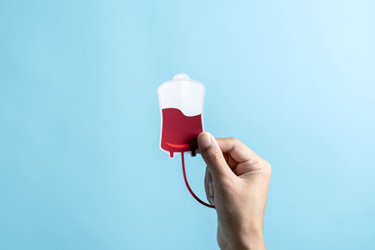Outsourcing At Cerus: Blood, Sweat … and FTEs?

By Louis Garguilo, Chief Editor, Outsourced Pharma

After four decades in the biopharma industry, including roles at NIH and Gilead Sciences, Nils Olsson may be undertaking his most complex role, as Vice President CMC, Cerus.
There’s a simple explanation for what Concord, California-based Cerus does: develop and supply vital technologies and pathogen-reduced blood components to blood centers, hospitals, and ultimately patients who rely a on safe blood supply.
If you or a loved one have been in a hospital setting needing a platelet or plasma transfusion, chances are good it was delivered in part by a Cerus’ INTERCEPT Blood System.
So that’s the simplification. But Olsson brings us behind the scenes, and into his challenging world of outsourcing and supply-chain management.
Hard To Categorize

Cerus, he says, doesn’t fit a category in line with the drug-developing biotechs we usually feature.
His organization does work with what it calls auxiliary compounds, and for “regulatory registration purposes” these are regarded as small molecule APIs, or as drugs themselves.
These compounds, manufactured at CDMOs, interact with viruses – or rather the genetic material of viruses and pathogens – to render them inactive or unable to replicate.
These compounds are provided to customers in a system of bags, tubes, and filters, regarded as a single unit and as a class three medical device.
Last but not least, Cerus works with blood banks that use this INTERCEPT Blood System to treat blood plasma components or donations, and these organizations also deliver the treated plasma components directly to patients.
“At that point,” explains Olsson, “we basically become a biologic, and regulated as naturally derived biologics at the blood bank level."
“So it's a bit of everything: small-molecule API, biologic at the end, and the system itself is regulated as a medical device.
“So it takes some work, it’s complicated, but interesting and certainly worth the efforts.”
Past As Prologue
Cerus performs R&D testing in its own laboratories, “but on the chemical, small molecule API side, we don't do organic synthesis or perform GMP manufacturing,” says Olsson.
“In that respect, we're completely reliant on large, and also some smaller CDMOs in the US and across the globe.”
And Cerus continues to look for more assistance across the globe “to increase flexibility in the supply chain, for either foreseen or unforeseen eventualities.”
“These challenges can spring up internally, from the market itself, or God knows what or where,” Olsson says. “Securing the supply chain is a big driver for me, and part of that is having backup plans and options.”
Not all CDMOs qualify. Mostly, the chemicals Cerus needs to produce its products would be described as traditional and familiar to external partners, but, for example, there is also an element of manufacturing highly potent compounds.
Olsson’s job is to find and work with the right-fit manufacturers, and as we’ll see, find the best way to manage those relationships.
He moved to Cerus in 2022 from a very different company, Gilead. I ask him what he might have learned about outsourcing during those five years that he can utilize today.
“Larger organizations already have their outsourcing systems in place and running,” he replies. “Smaller companies, including Cerus, still need to create those systems, and try out certain strategies.”
At Gilead, outsourcing “control mechanisms” had been in place for years. “I’m not saying they were the best in the world,” he says, “but they were functioning and well adhered to.”
“Something I took home from that experience is you have the option of outsourcing nearly an entire program: full R&D, analytic, development, quality control testing, and also, depending on the program, setting aside large portion of work for quality control testing by FTEs [full-time equivalents] in CDMOs in regions across the globe.”
Gilead was working with almost all the familiar CDMOs in the world, and many less familiar ones.
In some facilities, says Olsson, they could occupy whole dedicated floors, in China for example. “This is a comprehensive program-outsourcing model, and it can work effectively.
"If you are smaller, you don't have the experience, capacity or leverage to do that, but that experience at Gilead provided me a broader perspective of performing and measuring comprehensive development and manufacturing outsourcing.”
Projects Vs. People
That prior experience benefits the different and currently prevailing model at Cerus, where the company has "a number of FTEs at CDMOs 1, 2, 3, in countries X, Y, Z,” says Olsson.
“For me in the past, it was mostly what I call “project” outsourcing, and not necessarily “dedicated-resource” outsourcing. Today relying more on FTEs is a change."
Those full-time equivalent professionals across CDMOs work on a variety of tasks for six months to a year typically, and then those contracts can be extended or ended.
“The real difference from more large-scale development/manufacturing outsourcing is this specified relationship with those FTEs assigned to you. I’ve come to see that personal aspect clearly,” Olsson says.
“Nonetheless," he say, however or whatever way you outsource, "fundamentally you want someone else to fix a problem for you."
“The FTE model in my interpretation is, for example, working with scientists identified by name, and working as a direct extension of the professionals leading that project internally for you.
The opposite model, Olsson says, is less hands-on, leaving it up to the CDMO to figure out who does what, and working as they see fit in their own shop. The sponsor in this case most likely gets assigned a project manager to communicate with.
“So yes, with FTEs I know specifically who did the titration or ran the HPLC,” says Olsson.
He believes this relationship actually necessitates the sponsor to be more involved in giving direct instructions. “There’s more of a management role on the part of the sponsor.”
That can be more or less desirable, depending on the sponsor.
“We are in the process of carefully judging which works best for our company and each of our outsourcing needs."
